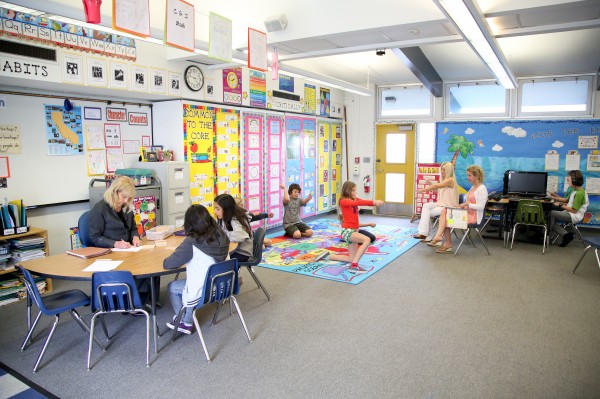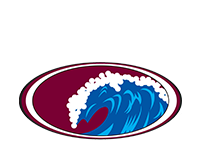In this class, acting out is encouraged.

With its emphasis on less is more, the new Common Core state-mandated academic standards still require teachers to cover certain subjects, but at a less hectic pace. The focus is depth rather than breadth of subject to engender greater understanding of one idea instead of the scattershot approach that required teachers to cover many subjects within an allotted amount of weeks.
Focusing on one thing at a time suits the learning style of Elizabeth Harris’s 22 kindergarten-through-fifth-graders, who mostly have been diagnosed with learning difficulties such as autism and ADHD.
“Before, in order to get through all of the standards, you had to really rush through everything,” said Harris. “Now, the Common Core has allowed us to take key concepts and expand them and really let the kids delve into them and explore them so we’re not just trying to rush onto the next thing. It was almost impossible for anybody to learn everything you were supposed to in one year.”
On a recent Monday morning at El Morro, four fourth-graders were “acting out” scenes in a required text, “Island of the Blue Dolphins,” by Scott O’Dell. Harris’s teacher’s aide, Jenny Carlson, reviewed details with students before they take a test later in the week. Her four young students sat on the floor as they listened attentively to the story, which is based on an actual account of a girl stranded on an island for 18 years, and acted out parts of the story, as any child would do.
Special education students are allowed to act out in class, said Harris, because it helps them to viscerally integrate the story. The more fully sensory the experience, the easier the story and its details are to remember when test questions come.
“It makes the material come to life,” said Carlson. When the class was reading and acting out a story about Mae Jemison, the first African-American woman in space, Carlson said one student called out, “ ‘My grandpa landed the Endeavor’ and, sure enough, he really did.”
Harris said she recently “gutted” her classroom to make it more Common-Core and hands-on ready. She put up four panels on the back wall that colorfully outline each of the Common Core objectives for language arts and math, which apply to all students across the board. Her special ed students are required to do the same work in small groups as the general education students do in larger classrooms.
“With small-group instruction for the kids, there’s a lot of room for community, and the kids, then, are free to make mistakes and work together and explore topics together,” said Harris. “As teachers, we’re also able to just be there and help guide them but then they can be more independent learners.”
Mike Morrison, the district’s new technology chief, began last week by meeting with the district’s school principals. They talked about rearranging the classrooms to be more conducive for collaborating as well as to provide privacy.
“There’s some neat furniture and some neat ideas coming out that will change the way teachers teach by reconfiguring the room, said Morrison, noting that businesses are learning that cubicles are isolating and even discourage productivity while too much open work area can become overly noisy for certain projects.
In her classroom, Harris added a wall mural of the ocean where a window might be. Just as colorful, she unfurled a rug that depicts each of the states and their capitols. The rug has become the stage for language arts stories and even math lessons. It’s not so bad being Mr. Common Denominator when Miss Multiplication is in the same equation.
Six of her fifth-graders were trying to figure out how many pizzas a coach needed to buy to feed his team of baseball players. The equation changed when the pizza was sliced differently and the team size shifted. It got a little complicated, and some heads were being scratched, but using snap-apart plastic blocks and small wooden pieces, called manipulatives, to denote pizza slices helped as did good, ol’ paper and pencil.
Still in its infancy, the Common Core standards are being initiated in Laguna Beach this school year with language arts and math. Science will come next fall.
“You can really do a lot more hands-on things,” said Harris, adding that she watched a science project in a second and third-grade combination class that was already learning by the new Common Core standards. Each student was trying to identify small piles of common household powders, like table salt and epsom salt.
“The kids were engaged, they were using their senses, they were writing down what they were discovering,” she said. “That kind of made it a cross-curricular activity. They were doing science, but they were also writing, they were working cooperatively, they were having to communicate with each other and share their ideas.”
Harris’s students spend 49 percent of their day in short pull-out sessions in the special education classroom and the rest of the time mixed in with the general education students. The in-depth study in her classroom allows her students to nearly be at grade-level in their general ed classes, she said.
“With my students, because they’re really doing well getting closer to grade-level, we’re able to incorporate more of the Core curriculum here,” said Harris. “They’re doing the same things in here in smaller groups and then they go back into their classrooms of 22 to 25 students and they’re at the same place.”
To accomplish this, she uses “open court” learning, which takes a general subject, last week it was survival, for the students to brainstorm openly. The subject word is written inside a center circle and the students surround it with words that reflect what they already know about survival, such as shelter, food and clothing. In the next sphere, they list words that show where they learned about survival; not surprisingly, from their parents, and surprisingly from Instagram, an online photo- and video-sharing social network, and from the CBS show “Survivor.”
Harris has brought in guest speakers to illustrate what the class is reading. She invited David Dartez, a former Defense Department worker who talked about landing the space shuttle Endeavor. For the survival segment, Harris is going to bring in a former El Morro student who survived brain cancer.
The point of the new Common Core teaching standards, Harris and Carlson agree, is to show students that making mistakes is part of the process and that a problem can be solved in a multitude of ways.
“We’re using the manipulatives, using pictures, using graphs,” said Carlson, “whatever it takes to get to the answer.”




